Online shopping diminishes the high-fashion experience
Is it really luxury if you can buy a loofah and a Louis bag in one click?
Luxury e-commerce is rising in popularity, but will it stick among high luxury retailers? (Illustration by Susan Behrends Valenzuela)
November 14, 2022
Whether you’re buying blue light glasses or cleaning supplies, the internet is the one-stop shop for convenience. Online retailers like Net-a-Porter, Amazon, and even couture house websites have capitalized on the rise of online shopping — they now sell millions of garments at the same prices as in-store. With the click of a one-day delivery button, couture items are at any shopper’s fingertips. Selling high-fashion garments is the crown jewel of retail, and the internet has harnessed the power of its marketability to make couture accessible to all. But, is buying a couture garment without the unique experience worth the price?
In the past five years, Amazon has successfully introduced designer items to its online storefront. Although this has made designer wear more readily available to consumers, it lessens the image of iconic couture houses. The ease of going on Amazon and purchasing the Marc Jacobs “Tote Bag” has increased the widespread reach of the brand, because shoppers know they can have it on their doorsteps in less than 24 hours. However, not all houses desire this reach.
During an earnings call meeting, a chief financial officer for LVMH, which owns Dior, Louis Vuitton and countless other influential houses, declared that they will not do business with Amazon because the company does not fit its business model or image. However, it is not just Amazon that diminishes the luxury shopping experience. Luxury shoppers want stores to go above and beyond for their customers, and to create an irreplaceable environment where there is no pressure to spend. Luxury shopping is not just what one buys — it’s about the message of the house, the item, and how the store fits with a person’s identity. When online, customers are only there to buy, not to engross themselves in the house aesthetics. The emotion of being in person is stripped away once a customer scrolls online because it is impossible to replicate through a screen.
Rising online giants like Net-a-Porter are challenging this lack of personable experience in e-commerce. At its foundation, Net-a-Porter understands that they must rethink retail as the future of luxury e-commerce and individualize an experience to compete with in-person retail. Net-a-Porter provides one of the world’s largest selections of designer brands, and new products are uploaded up to three times a week. This process allows shoppers to see everything they desire in one place, instead of clicking between platforms to shop. Net-a-Porter prides itself on its innovative customer service, which includes try-before-you-buy services, a shoppable print magazine, social media platforms, in-home personal shopping and a mobile app. This wide selection creates ease and makes designer garments more accessible for those who prefer to shop online.
E-commerce has also widened the initiative for luxury garments to be more sustainable. Platforms such as The RealReal, Poshmark, and Depop, which sell used products, are slowing down the trend cycle by making designer pieces more widely accessible at lower prices. These platforms have also widened the number of designer items available to a larger age demographic, rather than a narrowly tailored group. As buyers and sellers benefit from these platforms, luxury has become more environmentally friendly and the fashion industry has become more encouraging of wearing used pieces.
The individuality that accompanies in-person shopping is what embellishes its allure. When my mom and I went to Paris, we went to the Louis Vuitton store and told the saleswoman that we were just here for the experience. The woman said that was the best reason to be there, offering us a tour and recounting to us the history of Louis Vuitton and the effects of pop culture on the designs.
The woman then gifted me enough perfume samples that I still use them today. She wrapped them in the biggest Louis Vuitton box she could find and stuffed the bag with extra ribbons I could use in my hair. She did not care that the only item I purchased at the store was under $20 — she understood the power of the brand, and that luxury is about the experience that accompanies the product and not just the dollar amount spent.
Recently, I ordered a Missoni scarf online and was greeted with a cardboard box, which I forgot about after seeing the scarf. There was nothing warm or emotional about the experience. The memories instilled in designer wear are what make the items so coveted. The contrasting experiences made one thing clear: I would never receive the intimate in-person luxury shopping experience on the internet.
High-fashion shopping includes personalized help, unique stores with individual stories, and employees’ connection with their customers, none of which the internet can replicate. These characteristics cultivate an unforgettable transaction where customers will remember the experience of buying a bag rather than just the thoughtless entry of a credit card number.
It is impossible to maintain the experience of luxury retail when consumers can receive a Fall 2022 Yves Saint Laurent oversized wool peacoat and a new vacuum in the same box. High-fashion retail shopping is the world that the internet can not and will not conquer.
Contact Marisa Sandoval at [email protected].
























































































































































